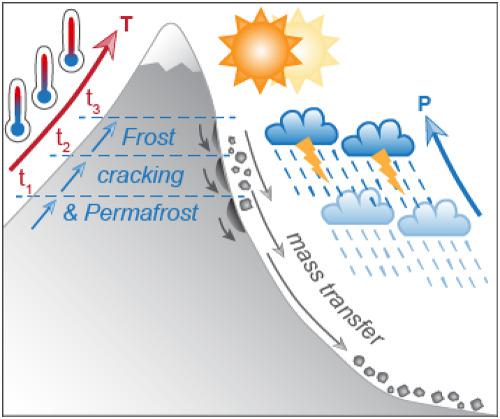当前位置:
X-MOL 学术
›
Earth Surf.Process. Land.
›
论文详情
Our official English website, www.x-mol.net, welcomes your
feedback! (Note: you will need to create a separate account there.)
Pronounced increase in slope instability linked to global warming: A case study from the eastern European Alps
Earth Surface Processes and Landforms ( IF 2.8 ) Pub Date : 2021-02-22 , DOI: 10.1002/esp.5100 Sara Savi 1, 2 , Francesco Comiti 2 , Manfred R. Strecker 1
Earth Surface Processes and Landforms ( IF 2.8 ) Pub Date : 2021-02-22 , DOI: 10.1002/esp.5100 Sara Savi 1, 2 , Francesco Comiti 2 , Manfred R. Strecker 1
Affiliation

|
In recent decades, slope instability in high‐mountain regions has often been linked to increase in temperature and the associated permafrost degradation and/or the increase in frequency/intensity of rainstorm events. In this context we analyzed the spatiotemporal evolution and potential controlling mechanisms of small‐ to medium‐sized mass movements in a high‐elevation catchment of the Italian Alps (Sulden/Solda basin). We found that slope‐failure events (mostly in the form of rockfalls) have increased since the 2000s, whereas the occurrence of debris flows has increased only since 2010. The current climate‐warming trend registered in the study area apparently increases the elevation of rockfall‐detachment areas by approximately 300 m, mostly controlled by the combined effects of frost‐cracking and permafrost thawing. In contrast, the occurrence of debris flows does not exhibit such an altitudinal shift, as it is primarily driven by extreme precipitation events exceeding the 75th percentile of the intensity‐duration rainfall distribution. Potential debris‐flow events in this environment may additionally be influenced by the accumulation of unconsolidated debris over time, which is then released during extreme rainfall events. Overall, there is evidence that the upper Sulden/Solda basin (above ca. 2500 m above sea level [a.s.l.]), and especially the areas in the proximity of glaciers, have experienced a significant decrease in slope stability since the 2000s, and that an increase in rockfalls and debris flows during spring and summer can be inferred. Our study thus confirms that “forward‐looking” hazard mapping should be undertaken in these increasingly frequented, high‐elevation areas of the Alps, as environmental change has elevated the overall hazard level in these regions.
中文翻译:

与全球变暖有关的边坡不稳定性显着增加:以东欧阿尔卑斯山为例
近几十年来,高山区的边坡失稳常常与温度升高和相关的多年冻土退化和/或暴雨事件的频率/强度增加有关。在此背景下,我们分析了意大利阿尔卑斯山(苏尔登/索尔达盆地)高海拔流域中小到中等规模群众运动的时空演化和潜在控制机制。我们发现,自2000年代以来,边坡破坏事件(主要是岩崩的形式)增加了,而泥石流的发生仅自2010年以来才增加。研究区域中当前的气候变暖趋势显然增加了岩崩的高度分离区约300 m,主要受霜冻和多年冻土融化的共同作用控制。相比之下,泥石流的发生没有表现出这样的高度变化,因为它主要是由超过强度持续时间降雨分布的第75个百分位的极端降水事件驱动的。在这种环境下,潜在的泥石流事件可能还会受到未固结碎片随时间推移的积累的影响,然后在极端降雨事件中释放出来。总体而言,有证据表明,自2000年代以来,萨尔登/索尔达河上游盆地(海拔约2500 m以上),尤其是冰川附近地区的边坡稳定性显着下降,并且可以推断出春季和夏季的落石和泥石流增加。因此,我们的研究证实,应在这些越来越频繁的人群中进行“前瞻性”危害图,
更新日期:2021-03-07
中文翻译:

与全球变暖有关的边坡不稳定性显着增加:以东欧阿尔卑斯山为例
近几十年来,高山区的边坡失稳常常与温度升高和相关的多年冻土退化和/或暴雨事件的频率/强度增加有关。在此背景下,我们分析了意大利阿尔卑斯山(苏尔登/索尔达盆地)高海拔流域中小到中等规模群众运动的时空演化和潜在控制机制。我们发现,自2000年代以来,边坡破坏事件(主要是岩崩的形式)增加了,而泥石流的发生仅自2010年以来才增加。研究区域中当前的气候变暖趋势显然增加了岩崩的高度分离区约300 m,主要受霜冻和多年冻土融化的共同作用控制。相比之下,泥石流的发生没有表现出这样的高度变化,因为它主要是由超过强度持续时间降雨分布的第75个百分位的极端降水事件驱动的。在这种环境下,潜在的泥石流事件可能还会受到未固结碎片随时间推移的积累的影响,然后在极端降雨事件中释放出来。总体而言,有证据表明,自2000年代以来,萨尔登/索尔达河上游盆地(海拔约2500 m以上),尤其是冰川附近地区的边坡稳定性显着下降,并且可以推断出春季和夏季的落石和泥石流增加。因此,我们的研究证实,应在这些越来越频繁的人群中进行“前瞻性”危害图,











































 京公网安备 11010802027423号
京公网安备 11010802027423号